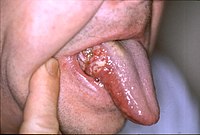
Photo from wikipedia
We read with great interest the systematic review and metaanalysis by Crocetta et al. [1] comparing sentinel lymphnode biopsy (SLNB) versus elective neck dissection (END) in early stage oral cancer.… Click to show full abstract
We read with great interest the systematic review and metaanalysis by Crocetta et al. [1] comparing sentinel lymphnode biopsy (SLNB) versus elective neck dissection (END) in early stage oral cancer. Two large prospective randomized-controlled trials (RCTs) and a pooled meta-analysis [2, 3] established the survival benefit of END over watchful waiting making it the contemporary standard of care in clinically node-negative (cN0) early stage oral cancer. SLNB was proposed over 2 decades ago as a strategy for management of early stage oral cancer through selective excision of the ‘sentinel’ node with meticulous histopathological examination (step-serial sectioning) thought to reflect the true nodal status of the remaining neck. Involvement of sentinel node by cancer cells requires completion neck dissection, whereas uninvolved sentinel node obviates the need for any further surgery, reducing morbidity and potentially impacting upon neck-dissection-related quality of life (QOL). The diagnostic accuracy of SLNB in early stage oral cancer has consistently been high. In the largest pooled analysis involving 5917 oral cancer patients enrolled in 98 studies [4], the pooled SLNB identification rate was 98%. SLNB was associated with an overall sensitivity of 82.7% and specificity of 98.1% with area under curve of summary receiver-operating characteristics (SROC) being 0.98 implying excellent diagnostic accuracy. To synthesize evidence, Crocetta et al. [1] pooled data from 5 non-randomized observational studies comparing SLNB with END to report on comparative effectiveness using neck recurrence rate (NRR), disease-free survival (DFS), and overall survival (OS) as efficacy endpoints. Data regarding morbidity from 4 studies were also included in a narrative summary. The NRRs between SLNB (n = 353) and END (n = 207) were not significantly different (10.5% vs 11.6%, respectively) with pooled risk ratio (RR) and 95% confidence interval (CI) of 1.09 (95% CI 0.67–1.76, p = 0.72). In terms of absolute numbers, the use of SLNB strategy led to 10 more recurrences per 1000 patients (ranging between 38 fewer and 88 more recurrences). However, this has to be weighed against the fact that SLNB spares unnecessary neck dissection in over 60% of patients. Reassuringly, none of the studies reported statistically significant differences in either DFS or OS between SLNB and END. As expected, SLNB was associated with lower rates of postoperative complication and shoulder dysfunction compared to END. No significant differences in QOL were recorded for the two approaches. However, quality of included studies was poor leading to very low certainty of evidence which precluded recommending SLNB as an evidence-based strategy in the management of cN0 neck in early stage oral cancer. Surprisingly, despite the low false-negative rates and high negative predictive values, SLNB was not compared directly with END in an RCT previously. Very recently, Garrel et al. [5] have demonstrated the oncologic equivalence of SLNB and END in clinically node-negative early stage oral/oropharyngeal cancer through an appropriately designed and adequately powered phase III RCT (level 1 evidence). Data from 279 patients were analyzed in a modified intention-totreat analysis with no significant difference (p = 0.91) in the 2 year neck node recurrence-free survival (RFS) between END (89.6%, 95% CI 83–84%) versus SLNB (90.7%, 95% CI 84–95%). Similarly, there was no significant difference in loco-regional RFS, disease-specific survival, and OS This comment refers to the article available online at https ://doi. org/10.1007/s0040 5-020-06090 -9.
Journal Title: European Archives of Oto-Rhino-Laryngology
Year Published: 2021
Link to full text (if available)
Share on Social Media: Sign Up to like & get
recommendations!